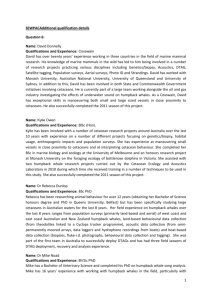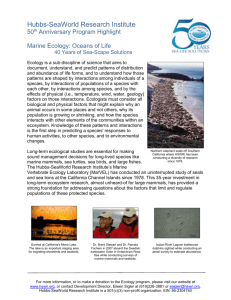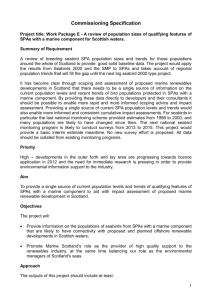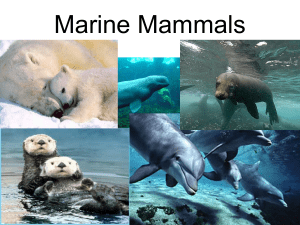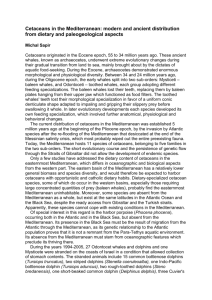PN3 Top Predators (Marine Mammals & Seabirds) - Mar-Eco
advertisement
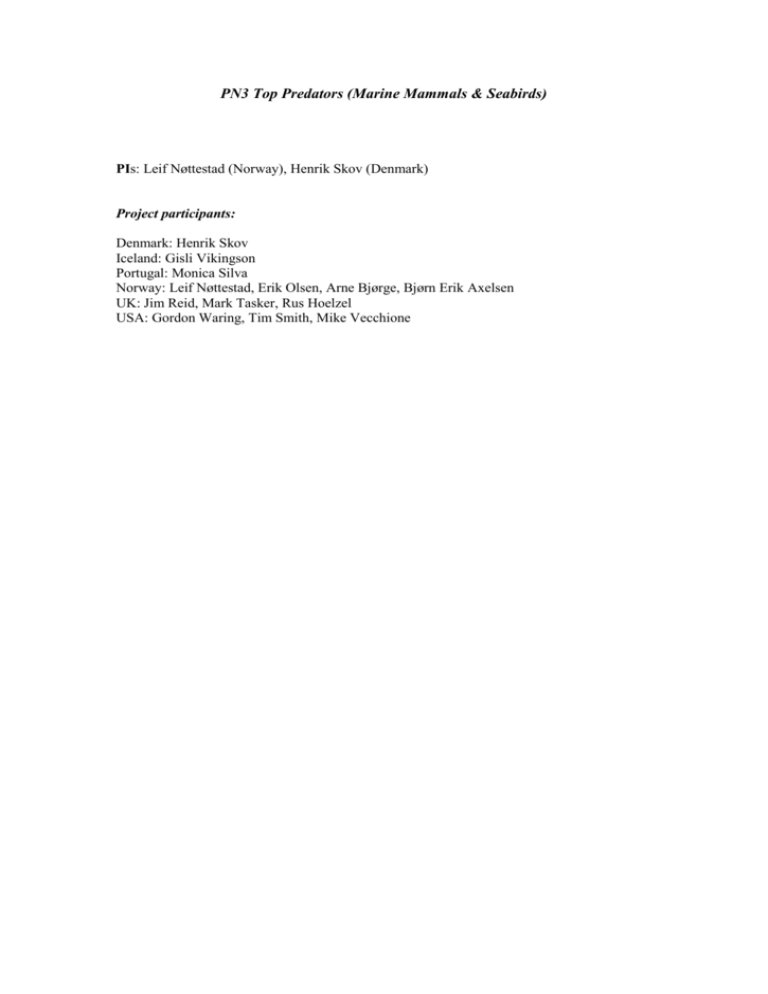
PN3 Top Predators (Marine Mammals & Seabirds) PIs: Leif Nøttestad (Norway), Henrik Skov (Denmark) Project participants: Denmark: Henrik Skov Iceland: Gisli Vikingson Portugal: Monica Silva Norway: Leif Nøttestad, Erik Olsen, Arne Bjørge, Bjørn Erik Axelsen UK: Jim Reid, Mark Tasker, Rus Hoelzel USA: Gordon Waring, Tim Smith, Mike Vecchione Table of contents Summary……………………………………………………………………………....3 Background and Rationale.…………………………………………………………..4 Project Objectives……………………………………………………………………..5 1) Distribution and migration of cetaceans and seabirds………………………5 2) Habitat use……………………………………………………………………..6 3) Interactions…………………………………………………………………….9 4) Models………………………………………………………………………….9 Methods……………………………………………………………………………….9 Field Approach……………………………………………………………………….9 Work plan and Schedule…………………………………………………………….12 Data analyses………………………………………………………………………...13 Budget.……………………………………………………………………………….16 Scientific publications, film documentary and public outreach.……………..……18 References...…………………………………………………………………………19 2 Identification of key oceanic habitats and ecological processes controlling the distribution of cetaceans and marine birds in the Central North Atlantic Summary Deep oceanic waters are some of the least studied ecosystems on Earth. The Mid-Atlantic Ridge (MAR) is characterized by rough bottom topography, hydrothermal activity and seamounts. There is growing evidence that this region has high biodiversity and bioproductivity. It supports several commercially important fisheries for deep-water species such as redfish, tusk, and Greenland halibut as well as orange roughy and blue whiting. The sparse quantitative information available about cetaceans and seabirds in the central North Atlantic indicates high abundance associated with the MAR. Data on the ecological role of cetaceans and seabirds within this ecosystem and the physical and biological processes including spatial distribution of their prey determining their distribution is lacking. The MAR area covers potentially important areas to breeding as well as non-breeding species of cetaceans. In addition, there are indications that the ridges and the associated hydrographical features attract large numbers of non-breeding seabirds. The main aims of this project will be: Map cetacean and seabird species composition and their temporal and spatial distribution of these species at varying scales in poorly surveyed area. Establish knowledge of habitat use of cetaceans and seabirds. Establish knowledge of behavioural interactions among and between cetaceans, seabirds and their prey at different spatial scales. Develop models of the relevance and importance of hydrographical and topographical features, associated prey distribution and front processes of the MAR in formation of seabird and cetacean habitats. This will include test of the models using data from all relevant studies within the MAR region. Use knowledge of behavioural interactions and habitat models to pinpoint key food webs and areas sustaining aggregations of pelagic prey. The project aims to reveal the spatial and temporal distribution, habitat use and migration of cetaceans and seabirds in the extremely scarcely studied MAR region. Focus will be put on the underlying processes and mechanisms governing cetacean and seabird distribution and migration in the MAR region, including 3D GIS analysis and modelling. We will also use aggregation of marine mammals and seabirds as indicator species related to the first signs and cues of important biological and ecosystem related areas and key oceanic habitats within MAR. A diverse array of visual and hydro-acoustic observation techniques will be applied. It is the plan and intention to perform biopsy sampling and satellite tagging on selected whales (sperm whales, fin whales and sei whales) from a mobile and fast zodiac when the opportunities are present. Advanced sonar technology will be used throughout the expedition to explore predator-prey interactions (marine mammals – fish/cephalopods and seabird – fish interactions) in very remote areas of the oceans. 3 The study has three phases: Phase 1 which is preparatory (2002-2003), Phase 2 which is the field phase 2003-2005, and Phase 3 (2004-2008) which is devoted to analysis and dissemination of results. 4 Background and Rationale Deep oceanic waters and the global system of mid-oceanic ridges are some of the least studied ecosystems on Earth. The MidAtlantic Ridge (MAR) is a tectonic spreading zone between the Eurasian and American plate running from Iceland in the North to the Azores in the South (Figure 1) and onwards through the South Atlantic. It is characterized by rough bottom topography, hydrothermal activity, seamounts and other particular topographical features. The ridge influences the circulation system in the North Atlantic and semi-permanent fronts and specific circulatory features associated with seamounts are characteristics of this region. There is growing evidence that this region has high biodiversity and bio-productivity (Sigurjonsson and Gunlaugson 1990; Sigurjonsson et al. 1991). It supports several commercially important fisheries for deep-water species such as redfish (Sebastes spp.), tusk (Brosme brosme) and Greenland halibut (Reinhardtius hippoglossoides) (Hareide and Garnes 2001) as well as orange roughy (Hoplostethus atlanticus) (Thomsen, 1998) and blue whiting ((Micromesistius poutassou) (Gerber 1993). The sparse quantitative information available about cetaceans and seabirds in the central North Atlantic indicates high abundance associated with the MAR. Data on the ecological role of cetaceans and seabirds within this ecosystem and the physical and biological processes including spatial distribution of their prey determining their distribution is lacking. Many of the cetacean species in the North Atlantic Ocean show large-scale feeding migrations to North Atlantic waters (north of ~50N) during summer. In the fall they leave these waters for breeding and wintering grounds in tropical and subtropical Atlantic waters. For all but a few species (e.g. humpback- and sperm whales) we have little or no knowledge of this southbound migration, the exact breeding grounds, their behaviour there, or the onset of the northward migration in the spring. The MAR area covers potentially important areas to breeding as well as non-breeding species of cetaceans. In addition, there are indications that the ridges and the associated hydrographical features of the Central North Atlantic attract large numbers of non-breeding seabirds. Figure 1. The Mid-Atlantic Ridge (MAR), which splits nearly the entire Atlantic Ocean north to south, is probably the best-known and most-studied example of a divergent-plate boundary with an average summit/crest depth of 2500 m. Transversal fracture zones (e.g., CharlieGibbs) disturb the longitudinal symmetry of the North Atlantic sea floor. The ridge topography is complex, containing submarine rises, several seamounts and banks, and oceanic islands of volcanic origins, all rising up from bathymal and abyssal depths, and troughs in 5 between. Less known are all the animals living along the Mid-Atlantic Ridge, including marine mammals and seabirds. The community of cetaceans and seabirds attracted to the rich waters of the MAR area provides an excellent subject for comparative studies of a wide range of North Atlantic top predators with respect to mechanisms governing ecological processes and oceanic habitats. MAR-ECO is an international research project under the Census of Marine Life (CoML) programme, and it is currently in its planning phase, which is funded by the A.P. Sloan Foundation in the USA and national funds. The MAR-ECO schedule comprises a planning phase in 2001-2003, a field phase in 2003-2005, and a data analysis phase in 2004-2008 (Bergstad 2002). The field phase will hopefully involve the concerted survey effort of 5-10 research vessels operating in the MAR region and thus so far Norwegian and Icelandic ships have been committed to the effort (R/V “G.O. Sars”, June-July 2004, , R/V “Arni Fridriksson”, June 2003). The ship-time available and the logistic framework offered by the MAR-ECO project offer a unique opportunity to conduct research on the biological oceanography and ecology of cetaceans and seabirds in the oceanic parts of the North Atlantic. MAR-ECO plans extensive survey effort to areas where little or no direct research on marine mammals and seabirds has been carried out previously. Although Mar-Eco is primarily focused on fish, zooplankton and cephalopods, it has always been the intention as far as possible to accommodate relevant studies of other organisms. The proposed seabird and mammal project addresses the Objectives 1 and 2 of the MARECO Science Plan: 1) Mapping species composition and distribution patterns. 2) Identification of trophic interrelationships and modelling food-web patterns. The Science Plan is downloadable from www.mar-eco.no. The MARECO project provides an excellent opportunity to conduct studies on a wide range of cetaceans and seabird species, using state of the art spatial analysis. This project fits well into the objectives 1 and 2 of the MAR ECO science plan. 1) Mapping species composition and distribution patterns. 2) Identification of trophic interrelationships and modelling foodweb patterns. Project objectives Principal Objective: Map cetacean and seabird species composition and their temporal and spatial distribution of these species at varying scales in this poorly surveyed area. Sub-goals: Establish knowledge of habitat use of cetaceans and seabirds. Establish knowledge of behavioural interactions among and between cetaceans, seabirds and their prey at different spatial scales. Develop models of the relevance and importance of hydrographical and topographical features, associated prey distribution and front processes of the MAR in formation of seabird and cetacean habitats. This will include tests of the models using data from all relevant studies within the MAR region. 1) Distribution and migration of cetaceans and seabirds 6 A number of cetacean species occur within the MAR region (Sigurjonsson and Gunlaugsson 1990; Sigurjonsson et al., 1991). We presume many of the large baleen whales such as fin whale (Balaenoptera physalus), sei whale (Balaenoptera borealis), and minke whale (Balaenoptera acutorostrata) use the Mid Atlantic Ridge during their annual migrations to northern latitudes in boreal and sub-arctic feeding areas in spring and summer, and during the southerly migration to sub-tropical and tropical areas in autumn and winter. Other species/groups likely to utilize the MAR include: beaked whales (Mesoplodont spp.), sperm whale (Physeter macrocephalus) (see Waring et al. 2001), humpback whale (Megaptera novaeangliae), Bryde’s whale (Balaenoptera edeni), pilot whale (Globicephela melas) and pelagic dolphins (Delphinids). Knowledge of the distribution and migration of sperm whales in the North Atlantic is poor, most information being obtained from the many whaling operations which have caught the species during the past two centuries. There is only one previous published record of a known individual sperm whale being identified at two different places in this ocean; male marked off Nova Scotia, Canada (42 degree 12'N, 65 degree 07'W) in 1966 was caught seven years later off NW Spain at 44 degree 10'N, 11 degree 20'W. A second record of a sperm whale movement within the North Atlantic and the first involving the heavily exploited groups occurring off Iceland and the Azores was documented by Martin (1982). Migrations of sperm whales from the Azores to the Norwegian Sea and Icelandic waters indicate the important role of the MAR as migration route for marine mammals. Significant morphometric differences between pilot whales in Newfoundland and Faroese waters may be caused by the isolation resulting from the physical barrier created by the front between the North Atlantic-Irminger Current and the East Greenland-Labrador Current. The front moves from south-west to north-east and turns north following the Mid-Atlantic Ridge, separating the northern North Atlantic in a western and an eastern gyre. This results in a segregation of the long-finned pilot whales occurring in the eastern and western parts of the North Atlantic (Bloch and Lastein 1993). Such physical barriers may increase our understanding of the migration patterns and stock boundaries for several cetacean species along the Mid-Atlantic Ridge. As the cetaceans seabirds are expected to utilise the MAR region extensively during migration and wintering, including species like Northern fulmar (Fulmarus glacialis), Softplumaged Petrel (Pterodroma mollis), Manx Shearwater (Puffinus puffinus), Great Shearwater (Puffinus gravis), and Cory’s Shearwater (Calonectris diomedea) (Skov et al. 1993; Ristow et al. 2000). Satellite tracking of Cory’s Shearwater migration, showed that two individuals, marked in Greece in the autumn, wintered east of the Mid-Atlantic Ridge at about 10 degree N and in equatorial waters (Ristow et al. 2000). From a seabird scientist perspective the MAR region is ideal to study habitat use due to absence of colonies within the foraging range that might confound the analysis of habitat selection. An aim in the proposed project will be to identify and record which species occur in the area at what times. Migrations of cetaceans and seabirds may be observed during the spring and autumn and breeding areas for cetaceans may be located within the MAR region. Degree of species overlap and interspecific behaviour can be identified to a certain extent and may reveal preferred habitats within the MAR region. Spatial and temporal variations in distribution, density and migration of cetaceans and seabirds will be analysed along with gradients in species diversity envisaged from deep oceanic areas towards the MAR region (Skov et al. 1993). We will develop an index of biodiversity, as there are indications that the biodiversity along the MAR is higher than elsewhere in the North Atlantic (Henrik Skov J. Biogeography / NASS surveys (Sigurjonsson and Gunlaugson 1990; Sigurjonsson et al., 1991). 7 2) Habitat use Habitat use of cetaceans and seabirds in this vast ocean area needs to documented and studied in more detail. We do not know what biotic and abiotic mechanisms governs the distribution and habitat use along the Mid Atlantic Ridge, or what kind of temporal or permanent hydrographical, and topographical structures there exist in these areas. This knowledge needs to be linked and related to current knowledge of other oceanic ecosystems, to explore whether similar patterns are valid along the MAR region. We expect to find high concentrations in conjunction with prey aggregating along hydrographical, topographical and biological structures (oceanic fronts, upwelling, eddies, seamount etc.) on a seasonal or annual basis (see Figure 2). In a study on the distribution of Procellariiformes in the Central North Atlantic all major concentrations of seabirds were located at oceanic fronts (Skov et al. 1993). In the upper 20 m we would expect seabirds (because of their flying ability and rapid spatial movement) to use exploit less predictable small-scale habitats to a larger degree than cetaceans that by virtue of their diving abilities have access to more predictable frontal structures and prey aggregations deeper in the water column (see Figure 2). Seabirds and cetaceans will to a large extent use different parts of the water column in relation to their feeding constraints. It is important to realize that they are living in a 3D environment, so both horizontal and vertical habitat use will be studied and cetacean and seabird 3D habitat use will be compared. We will then apply state of the art 3D GIS technology to build a digital database of the structure of the water column, specifically the depth and strength of frontal structures, and the topographic relief of the MAR region. The 3D digital databases will then be related to the distribution of cetaceans and seabirds. Comparative analyses of cetacean and seabird habitat have not previously been made at this large scale. Dominant deep-water fish species and potential prey species for marine mammals along the Mid-Atlantic Ridge has recently been collected from trawl and longline exploratory surveys at 400- 2000 m depth. In the northern part of the Ridge (north of 52 degree N) sub-Arctic species such as Sebastes spp., tusk and Greenland halibut are dominant. In the southern part (south of 48 degree N), sub-tropical species such as golden eye perch (Beryx splendens) and cardinal fish (Epigonus telescopus) are the dominant species. The area between 48 and 52 degree N is a region of faunal change where some species seem to be at either the northern or southern limit of their distribution. The most abundant fish species on two seamounts of the MAR approximately 300 miles north of the Azores were Portuguese shark, roundnose grenadier, black scabbard, Baird’s smoothhead, blue ling and orange roughy (Connolly and Kelly 1997). Blue whiting is also quite common along the MAR region, especially in relation to seamounts (Gerber 1993). Silver hake, (Merluccius bilinearis) is found within the region as well as orange roughy (Hoplostethus atlanticus) (Thomsen, 1998). Their diet consisted mainly of deep-sea fish species, shrimps and cephalopods. In the fishery for orange roughy, large bycatches of deep-sea cardinal fish and roundnose grenadier (Coryphaenoides rupestris) have been taken. They are consumers of various fish and large crustaceans in the thalassobathyal zones of Reykjanes Ridge (Gushchin and Podrazhanskaya 1984). Deep-sea hydrothermal vents and cold seeps are submarine springs where nutrient-rich fluids emanate from the sea floor. Vent and seep ecosystems occur in a variety of geological settings throughout the global ocean and support food webs based on chemoautotrophic primary production. Most vent and seep invertebrates arrive at suitable habitats as larvae dispersed by deep-ocean currents. The recent evolution of many vent and seep invertebrate species (<100 million years ago) suggests that Cenozoic tectonic history and oceanic circulation patterns have been important in defining contemporary biogeographic patterns (Van Dover et al. 2002). Decapod shrimps (family Bresiliidae) dominate the fauna at vents on the Mid-Atlantic Ridge (Polz et al. 1998; Herring et al. 1999). The Nautile (June-July 1988) on the Mid- 8 Atlantic Ridge, at 23-degrees-N, observed a rich ichthyofauna with, at least, two zoarcid fishes, one synaphobranchid fish, and one bythitid fish. These data show the importance of synaphobranchid fishes in the vent communities, and they confirm the endemism and uniqueness of the fauna at hydrothermal vents, especially fishes, and their similarity between the Pacific and Atlantic Oceans (Geistdoerfer 1991). 1 6 5 4 Pelagic 3 2 8 11 12 1500 Bathy-pelagic 9 200 Meso-pelagic Cold Water Mass Warm Water Mass 7 0 10 SEAMOUNT Demersal 3100 3300 FIGURE 2 Schematic representation of a hypothetical MAR front system with pelagic, meso-pelagic and bathy-pelagic communities. The oceanic front causes a local upwelling effect, which indirectly or directly support a large zooplankton biomass. The zooplankton are preyed upon by small pelagic necton (3). In both water masses baleen whales such as sei whales (6) prey directly on the zooplankton and fish, while various dolphin species prey on the fish fauna. In the warmer water masses sea turtles are predators on the fish, but also on various jellyfish species. In the meso-pelagic community various fish species (8) are preyed upon by deep diving whales such as beaked whales. Beaked whales also forage at deeper depths in the bathy-pelagic zone on fish (9) and various squid species (11). Squid are 9 also the main prey of sperm whales (12) and pilot whales that routinely forage at these depths. Seabirds will prey on fish and squids available close to the surface. 3) Interactions Predator-prey interactions will be studied in more detail within the project. Visual observations of marine mammals and seabirds foraging close to surface will be performed and we aim to film selected predator-prey interactions applying digital technology. Hydroacoustic recordings of predator-prey interactions underwater down to approximately 100 m will be done using state of the art multi-beam high-frequent sonar and echosounder technology. This method has been used with great success on seabird-fish interactions (Axelsen et al 2001), predatory fish-schooling fish interactions (Nøttestad 1998) and marine mammal-fish interactions (Nøttestad and Axelsen 1999; Nøttestad and Similä 2001; Nøttestad et al. 2002). Knowledge on seabird feeding ecology (see Hatch et al. 2000), and predation model for fish eating birds (see Ollason 2001a, b) are available and will be further developed. 4) Models Distribution of top-predators is usually studied in a one-species, top-down survey approach. There have been few attempts to predict top-predator distribution based on prey availability, hydrography, topography and climate. We will use the 3D digital databases on hydrographical and topographical structure as a basis for prediction models for cetacean and seabird distribution. The models will be tested against independent data collected from other MARECO surveys and relevant historic surveys carried out in the MAR region. Once the models are established we can demonstrate the use of the distributional and behavioural characteristics of top predators as indications of the key food webs and sites of increased abundance of pelagic prey in the MAR. Methods Field approach We envisage two seasons (in two consecutive years) of fieldwork. At each station, where the vessel is stationary, we will need the following data: CTD profile ADCP Profile Trawl samples of pelagic and bathypelagic fish and zooplankton species composition and abundance. Achieving objectives Objective 1 Visual observations of cetaceans, seabirds and sea turtles will be used to map their distribution and species composition. Therefore having observers on board as many research vessels operating within the MAR region in 2003 and 2004 will be the key to gaining comprehensive knowledge. We envision three dedicated observers aboard each ship for the duration of each cruise. Cruises that are relevant to this project, should include collection of hydrographic data, prey abundance (zooplankton, bathypelagic nekton, cephalopods and fish) and acoustic data. The cruises should ideally cover as large portion of the MAR as possible. 10 Synoptically we wish to collect hydrophone data from towed hydrophone arrays. These data will be analysed at the completion of each cruise. We also wish to place stationary hydrophones on the CTD rigs, which are planned to be deployed within the MAR-ECO project. A total of 10 satellite tags will be attached opportunistically to two species: Sei and minke whales using air-gun technology developed by Heide-Jorgensen et al. (2001). Objective 2 Ensure that data from surveys and stationary platforms are collected at sufficient spatial and temporal scales to analyse cetacean and seabird 2D and 3D habitat use. Objective 3 We wish to conduct some dedicated cruise-time on specific surveys to achieve objectives 2 and 3, but also to supplement data employed for determination of habitat use. Based on distribution of cetaceans and seabirds observed in year 1, we will dedicate cruise time in year 2 to study interactions with prey using trawl sampling and acoustic monitoring. In cetacean and seabird high-density habitats, we plan to observe foraging of individual and groups of seabirds and cetaceans. We expect seabirds and baleen whales to forage in the upper 100 m of the water column, most probably on zooplankton and small pelagic fish. These interactions will be observed and quantified from visual observations of surface behaviour, and sonar / echosounder monitoring of predator and anti-predator behaviour. Prey species will be identified from pelagic trawl and plankton-net sampling. To better understand how individual whales target prey species we wish to attach acoustic 300 kHz depth modulated pingers to individual whales (see Jain and Gupta 1997). The pinger signals will be observed on the onboard sonar and allows for positioning of the whale within the water column with a 10 m precision. A 300 kHz acoustic signal is well above the known audible limit of cetaceans, and should therefore not interfere with their natural behaviour. Many species of toothed cetaeans (delphenids, sperm whales and beaked whales) are also found within the MAR region. Some of these species are poorly studied, but data available indicate that they feed on bathypelagic nekton and cephalopods. To study the interaction of these species with their prey requires towed underwater acoustics and deep-water trawling. Acoustic observations of direct interactions between whales and prey should be rare, but as all species use bioacoustics to find prey, hydrophones can be used to monitor their foraging behaviour based on the sounds they emit. Using a directional hydrophone on the towed underwater vehicle it will be possible to find where in the water column they forage, and what prey is present. Objective 4 Objective 4 is a synthesis of objective 1-3 aiming at developing and testing the models of habitat use, and predator-prey interactions in a wider area of the MAR ecosystem and at demonstrating the use of cetaceans and seabirds as indicators of areas of enhanced aggregation of pelagic prey in the MAR. This requires no additional fieldwork, but independent data from other cruises within the MAR region. Access to these data is therefore vital. 11 Workplan and Schedule TASK 2003 Icelandic Survey (June) 4 marine mammal, 1 seabird scientist 2004 2005 Arni Fredriksson (Northern part of MAR (limited coverage) Russian Survey (June) 1 marine mammal/seabird scientist Northern part of MAR (extensive coverage) German Survey (Nov/Dec) 1= marine mammal/seabird scientist Oasis - southern part of MAR (small box area) Discovery- middle part of MAR Portugese Survey (June/July) 2=marine mammal and 1=seabird scientist Navy vessel - southern part of MAR Norwegian Survey (June and July) G.O.Sars - middle and southern part of MAR 4=marine mammal and 2=seabird scientist German application (needs to be decided later) 2=marine mammal and 1=seabird scientist UK application (needs to be decided later) 2=marine mammal and 1=seabird scientist 12 Data analysis Data analysis is planned as a continuous and integral part of the whole project, and is envisioned to extend 18 months past the second field season. Spatial and temporal patterns will be analysed after the first year, and used to plan the second year field experiments. 1- Mapping and distribution A major challenge will be to effectively link data collected at different spatial scales (from research vessels, satellites, stationary CTD platforms). In addition the project faces the challenge of extrapolating data collected at small temporal scales to longer periods. With respect to the latter we will attempt to solve this by linking all data by using advanced rasterbased GIS-analysis. We will conduct time-series analysis of acoustic cetacean activities recorded by stationary hydrophone-CTD platforms. Visual and acoustic data of cetaceans and seabirds recorded on transect will be used to estimate abundance / activity indices. We will develop geostatistical (kriging) models of the distribution of cetacean and seabirds as a basis for mapping their pattern. Variations in the structure of the diversity of the cetacean and seabird communities will be described using rank-abundance curves and other measures of community structure. Spatial data of the following is needed for planning field season 2 and further analysis: Bottom topography and relief 3D database (interpolated data) of: o Water column structure (salinity, temperature, oxygen) o Currents through the water columns (ADCP data) o Acoustic recording 2D database (interpolated data) of: o zooplankton abundance o trawl data The spatial data will be used to construct 3 D visual models of the MAR which can be presented to end users on a web page. Satellite track data of tagged whales will be analysed in relation to hydrographical and satellite data in a GIS framework. 2- Habitat use Raster-based GIS will form the platform for most analysis of area use of seabirds and cetaceans. This will allow us to address scale-dependencies effectively. Classify the areas according to physical structure. We suggest that area classification becomes an integral part of the whole MARECO project. Classification of areas: Bottom topography o Construct deep fine-scale digital elevation model (DEM) o Depth and slope (classifications of seamounts, ridges etc.) Surface hydrography o 2D interpolation of surface data and satellite images (NOAA-AVHHR, Envisat, SEAWifs) o Strength of fronts (gradient) Watermass distribution o Distribution of coarse scale (10 – 100 km) fronts o Distribution of meso-scale eddies (rings) Water column structure (CTD / ADCP) o Depth of the upper and lower mixed layer 13 o Depth and width of pycnocline Link distribution data on cetaceans and seabirds to physical structures: A number of raster-based analysis will be carried out based on physical and biological data, the more important being seabird and cetacean use of areas of different prey species availability, water column characteristics, bottom topography and surface patterns. Statistics to be estimated will be Euclidean distance between observed cetacean and seabird distributions and physical structures, and habitat selection functions. A time delay likely exists between biological and physical factors contributing to prey aggregations and predator arrival (seabirds vs. cetaceans). Develop indicators of animal activity from hydrophone recordings of cetacean vocalization recorded from stationary CTD platforms. o There is little shipping in the southern area of MAR, which potentially could disturb the natural behaviour of seabirds and cetaceans. In the northern MAR (Reyjkanes Ridge) fishing activities may potentially interfere with behaviour o Identify cyclic (temporal trends) activity in vocalization. In order to link to temporal variation of cetacean activity to hydrographical data the temporal analysis of the stationary CTD platforms is required. 3- Predator-prey interactions Quantitative analysis of cetacean predator behaviour towards different prey and at different times of day o Video analysis of sonar and echosounder recordings (classify and quantify behaviour). o Analysis of post-processed sonar data (prey identification, size, density, depth of fish aggregations). Ground-truthing by biological sampling. o Possible quantification of threshold foraging and interactions. o Visual observations of cetacean and seabird foraging behaviour will be analysed using the mapping methods described above (including the analysis of multi-species occurrences). 4- Modelling work Based on the results of habitat selection and feeding interactions, spatial models, will be developed on the use of topographical and hydrographical structures and prey characteristics. By using interpolated data we will be able to take into account auto-correlation effects. Based on these models, maps of suitable habitats will be prepared of a larger part of the North Atlantic. The location of predicted high density areas and key migration corridors of cetaceans and seabirds will be verified by the use of quality assured data sets. For seabirds this means using the European Seabirds At Sea database (ESAS), and the ‘PIROPS’ database (Canada). For cetaceans this will imply using data from North Atlantic Sighting Surveys and the sightings databases (e.g. OBIS-SEAMAP, http://www.obis.env.duke.edu/), of eastern US and Canada, Azores and other locations. 14 2003 Hours € ex VAT Costs Co-ordination IMR DHI Field work IMR DHI WHOI PORT JNCC Cruise expenses 75 75 150 150 IMR DHI WHOI PORT JNCC 2004 Hours € ex VAT 7509 6750 75 75 7509 6750 13500 15000 300 450 300 300 28035 40500 30000 13500 IMR DHI WHOI PORT JNCC 0 1875 1875 0 0 Database management IMR DHI 0 7200 80 100 75 40500 450 9000 4673 10800 Total Hours € ex VAT 250 225 25031 20250 300 1050 450 300 450 28035 94500 45000 13500 9000 14063 18750 65625 28125 18750 14063 0 5625 0 0 2813 3750 13125 5625 3750 2813 28125 3750 5625 3750 3750 50 120 10013 6750 450 18750 28125 18750 18750 9375 9375 Per diem 2005 Hours € ex VAT 50 80 4673 7200 100 280 9345 25200 15 WHOI PORT JNCC Analyses - mapping IMR DHI WHOI PORT JNCC Analyses - predator/prey interactions IMR DHI WHOI PORT JNCC Analyses - habitat modelling Travel 80 40 8000 1800 120 60 12000 2700 80 40 400 8000 1800 9200 280 140 400 28000 6300 9200 100 50 50 0 9000 5000 2250 0 100 50 50 0 9000 5000 2250 0 120 75 65 400 0 10800 7500 2925 9200 0 320 175 165 400 0 28800 17500 7425 9200 300 28035 600 50 50 56070 4500 5000 600 50 50 56070 4500 5000 400 9200 1500 100 100 0 400 140175 9000 10000 0 9200 200 150 50 18690 13500 5000 400 9200 400 300 150 0 400 37380 27000 15000 0 9200 IMR DHI WHOI PORT JNCC 0 0 0 0 0 IMR DHI WHOI PORT 2000 6000 6000 200 150 100 18690 13500 10000 4000 6000 4000 4000 5000 6000 5000 4000 11000 18000 15000 8000 16 JNCC Equipment Total 6000 Satellite tags (20) DST tags (5) Acoustic pingers (10) Satellitedata Hydrophones Other IMR DHI WHOI PORT JNCC Total INST EQUIPMENT 9000 15000 78947 6579 13152 1316 1316 39474 78947 6579 13152 3948 39474 5000 1316 5000 375 405 280 90 37544 42450 34000 4050 119737 1225 945 620 710 118977 91050 66000 50485 21047 950 925 255 105 2500 4735 94445 89250 30500 8725 71675 294595 6316 2550 2275 1155 905 3100 9985 239966 204750 115500 55260 140300 755776 147100 902876 GRAND TOTAL 17 Environmental and ethical concerns There are no direct environmental concerns pertaining to this project. The placement of stationary platforms may cause some local disturbance on the benthic fauna, but this is covered in greater depth in the project description of the stationary platforms. Attaching tags to cetaceans is a widely accepted method for studying their movements and behaviour, and causes some immediate pain to the animals when the tag is shot into the blubber of the animal. No long-term harmful effects of such tagging have been observed, and the animals expel the tags in 3-6 months time, leaving only a small scar. Scientific publications, film documentary and public outreach We intend to educate and inform as many people as possible interested and potentially interested in marine mammal and seabird biology and ecology. We shall therefore publish results to a broad spectre of scientific and non-scientific communities in a national and international context: 2 international peer reviewed scientific papers 2 popular science articles 4 international and national newspaper articles 2 oral presentations at international symposia 1 Nature Documentary (26 min) on an international television channel Involve school classes to increase their interest on marine science in general Produce and maintain an interesting and appealing web page on internet Relevant results obtained from the cruises, GIS and modelling work will be published in international high standard per-reviewed journals. We also want to reach a wider audience by writing illustrated articles in popular science magazines and newspapers. An updated web site will also be arranged within the project. This web site can be used in relation to educational purposes in school programs at different levels (high school to universities). Since this is an exploratory project in a vast but nevertheless very little studied ecosystem of the Atlantic Ocean, we will probably gain publicity from the international press and media. Marine mammals, seabirds and deep-sea creatures are popular animals and should be of considerable interest to an international audience. Positive spin offs from this project will include increased interest to natural science and conservation of marine mammals and seabirds by the general public and to educational institutions. The methodology applied in this project and the concepts introduced could be of valuable assistance to other similar field studies. As within most field studies and modelling work, new interesting and important questions will arise and form the basis for new studies and projects. 18 References Axelsen, B.E., Ancher-Nilsen, T., Fossum, P., Kvamme, C., and Nøttestad, L. 2001. Pretty patterns but a simple strategy: predator-prey interactions between juvenile herring and Atlantic puffins observed with multibeam sonar. Canadian Journal of Zoology 79:1586-1596. Bergstad, O.A. 2002. Internasjonal undersøkelse av dyrelivet langs Den Midtatlantiske rygg. Havets Miljø 2002 p. 86-88. (In Norwegian). Bloch, D., and Lastein, L. Mophometric segregation of long-finned pilot whales in Eastern and Western North-Atlantic. Ophelia 38:55-68. Connolly, P.L., and Kelly, C.J. 1997. Deep water trawl and longline surveys in 1995. Fish. Leafl. Dep. Mar. 173, 20 pp. Geistdoerfer, P. 1991. The deep-sea fish fauna of hydrothermal vents, with a description of a new synaphobranchid genus and species thermobiotes-mytiligeiton (Pisces, Anguilliformes) in the Pacific Ocean. 1991. Comp. Rendus Academ. Sci. Ser. III-Sci. Vie–Life Sci. 312:91-97. Gerber, E.M. 1993. Some data on the distribution and biology of blue whiting, Micromesistius poutassou , over the Mid-Atlantic Ridge. Voprosy ikhtiologii. 33:61-65. (Moscow, in Russian). Gushchin, A.V., and Podrazhanskaya, S.G. 1984. Feeding of roundnose grenadier (Coryphaenoides rupestris) and its trophic relationships in the North Atlantic. Nafo Sci. Counc. Stud. 7:53-59. Hareide, N.R. and G. Garnes 2001. The distribution and catch rates of deep water fish along the Mid-Atlantic Ridge from 43 to 61 degree N. Fisheries Research 51:297-310. Hatch S.A., Meyers P.M., Mulcahy D.M., Douglas D.C. 2000. Seasonal movements and pelagic habitat use of murres and puffins determined by satellite telemetry. Condor 102(1):145-154. Heide-Jorgensen M.P., Kleivane L., Oien N., Laidre K.L., Jensen M.V. 2001. A new technique for deploying satellite transmitters on baleen whales: Tracking a blue whale (Balaenoptera musculus) in the North Atlantic. Marine Mammal Science 17 (4):949954. Herring, P.J., Gaten, E., and Shelton, P.M.J. 1999. Are vent shrimps blinded by science? Nature 398:116. Jain S.K., and R. Gupta 1997. Development of a miniature acoustic pinger tag device for tagging on to fish for fish behavioral studies. Indian J. Mar. Sci., 26(2):234-237. Martin, A.R. 1982. A link between the sperm whales occurring off Iceland and the Azores. Mammalia, 46(2):259-260. Nøttestad, L. 1998. Extensive gas bubble release in Norwegian spring spawning herring (Clupea harengus L.) during predator avoidance. ICES Journal of Marine Science 55:1133-1140. Nøttestad, L., and B.E. Axelsen 1999. Herring schooling manoeuvres in response to killer whale attacks. Canadian Journal of Zoology 77:1540-1546. Nøttestad, L., and Similä, T. 2001. Killer whales attacking schooling fish: Why force herring from deep water to the surface? Marine Mammal Science 17:343-352. Nøttestad, L., Fernö A., and Axelsen, B.E. 2002. Digging in the deep. Killer whales’ advanced hunting tactic. Polar Biology 25:939-941 Ollason J.G. 2001a. A model of the foraging behaviour of a diving predator feeding underwater at patches of food, 1. IMPRESS Report 2001.006. University of Aberdeen, Newburgh. Ollason J.G. 2001b. A model of the foraging behaviour of a diving predator feeding underwater at patches of food, 2. IMPRESS Report 2001.007. University of Aberdeen, Newburgh. Polz, M.F., Robinson, J.J., Cavanough, C.M., Van Cover, C.L. 1998. Trophic ecology of massive shrimp aggregations at a Mid-Atlantic Ridge hydrothermal vent site. Limnol. Oceangr. 43:1631-1638. 19 Ristow, D., Berthold, P., Hashmi, D., Querner, U. 2000. Satellite tracking of Cory’s Shearwater migration. Condor 102:696-699. Sigurjonsson, J., Gunlaugsson, T. 1990. Distribution and abundance of cetaceans in Icelandic and adjacent waters during sightings surveys July-August 1989. ICES council meeting 1990 (collected papers), ICES, Copenhagen (Denmark), 26 pp. Sigurjonsson, J. Gunlaugsson, T., Ensor, P., Newcomer, M., and Vikingsson G. 1991. North Atlantic sighting survey 1989 (NASS-89): Shipboard Surveys in Icelandic and Adjacent Waters July-August 1989. Report for the International Whaling Commission 41:559572. Skov, H, Danielsen, F., Durinck, J. 1993. The distribution of Procellariiformes in the Central North Atlantic. Die Vogelwarte 37: 270-289. Thomsen, B. 1998. Faroese quest of orange roughy in the North Atlantic. ICES CM/O:31, 8 pp. Van Dover, C.L., German, C.R., Speer K.G., Parson L.M., Vrijenhoek R.C. 2002. Marine biology - Evolution and biogeography of deep-sea vent and seep invertebrates. Science 295 (5558):1253-1257. Waring , G.T., Hamazaki, T, Sheehan, D., Wood, G., Baker, S. 2001. Characterization of beaked whale (Ziphiidae) and sperm whale (Physeter macrocephalus) summer habitat in shelf-edge and deeper waters off the Northeast US. Marine Mammal Science 17:703717. 20
